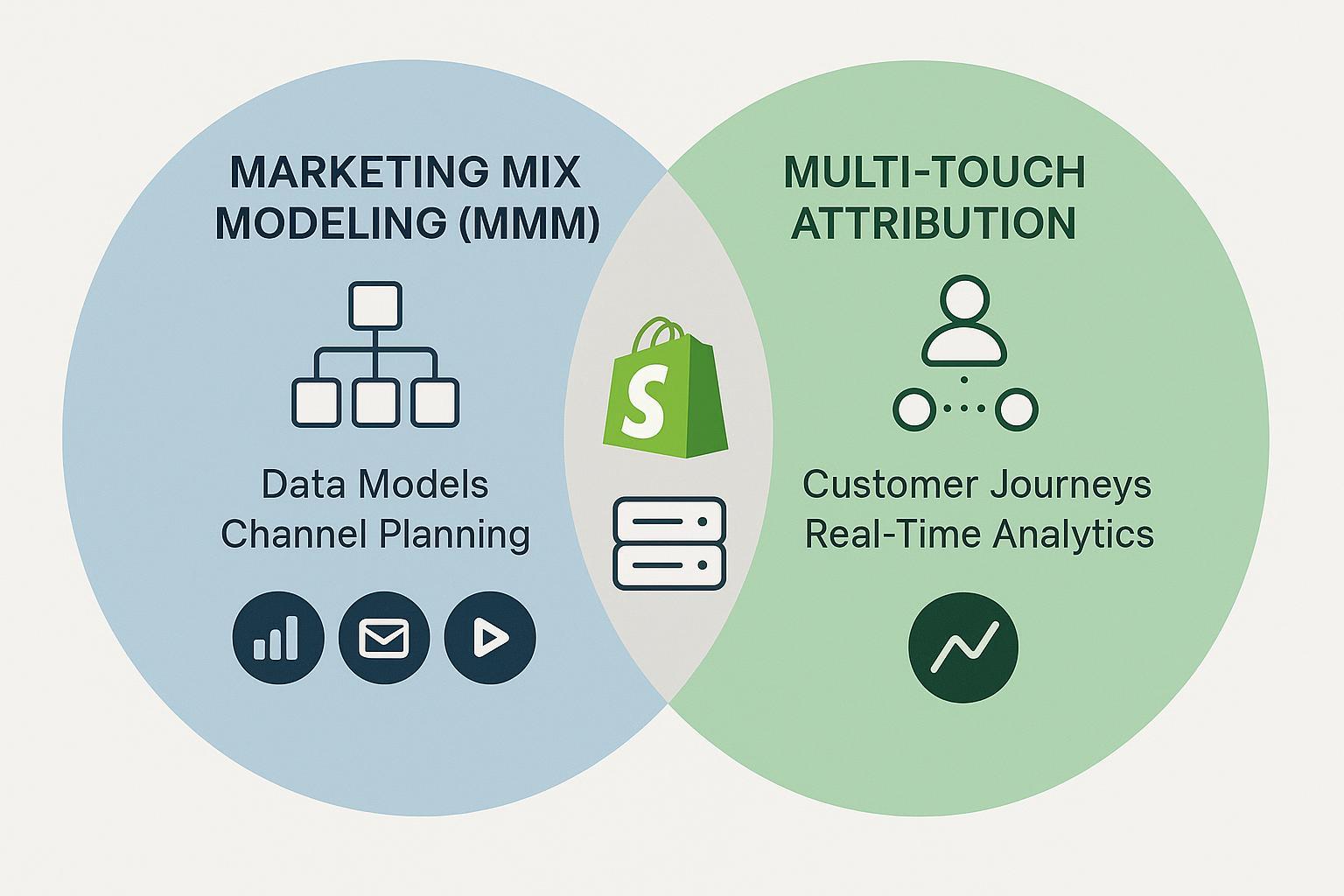Understanding the Key Differences Between Marketing Mix Modeling and Attribution (2025 E-commerce Edition)

Choosing the right measurement approach in 2025 can mean the difference between blindly spending and data-driven, profitable growth for e-commerce brands. This guide breaks down Marketing Mix Modeling (MMM) vs. Multi-Touch Attribution (MTA), puts everything in the Shopify/DTC context, and shows how platforms like Attribuly bring real-world clarity and actionability to modern marketers.
1. MMM vs. Attribution: Fast Definitions & Why This Matters in 2025
- Marketing Mix Modeling (MMM): Uses statistical models (increasingly AI-driven) to analyze how all marketing activities—across online (Google, Meta, TikTok), offline (TV, OOH), and non-media factors (pricing, weather)—impact total sales. MMM works with aggregate data (not user-level) and is prized for its privacy-safety and cross-channel scope.
- Best for: Strategic budget allocation, big-picture insights, and navigating privacy-first environments. [See: Avada.io MMM Guide]
- Marketing Attribution (Especially Multi-Touch): Connects every tracked marketing touchpoint (ad click, email, organic visit) to actual customer journeys and conversions, ideally across devices and channels. Multi-touch models split revenue credit across multiple steps, allowing for detailed, actionable campaign optimization—in real-time.
- Best for: Optimizing digital ad ROI, channel/creative ramp-up, testing campaigns, and identifying what truly influences customer action.
Why it matters in 2025:
- Privacy’s new reality: Cookies are fading, data fragmentation is everywhere, and e-comm brands must balance targeting with compliance (GDPR, CCPA).
- E-commerce complexity: Shopify, DTC, and omnichannel brands mix many ad platforms, and need to prove—and improve—ROI fast.
2. Core Comparison: How MMM and Attribution Differ (with Visual Matrix)
| Dimension | Marketing Mix Modeling (MMM) | Marketing Attribution (MTA/Multi-Touch) |
|---|---|---|
| Data Granularity | Aggregate sales, channel/campaign | User-level, touchpoint-by-touchpoint |
| Channels Covered | Online, offline, non-media | Online (all), some offline |
| Primary Use Case | Macro budget planning, scenario test | Channel, campaign, creative optimization |
| Privacy Compliance | Very strong—no user tracking needed | High—1st-party, server-side, modeled data |
| Setup & Data Needs | Weeks/months, historical data req’d | Days; real-time tracking post-setup |
| Platform Examples | Robyn, Meridian, Conjura | Attribuly, Triple Whale, Northbeam, Rockerbox |
| Best for Brands | Large, complex, multi-channel | DTC, Shopify, digital-first, SMB/enterprise |
| Actionability Speed | Quarterly/annual changes | Instant-to-weekly optimization |
| Cost Range (2025) | $15K–$100K+/year (agency/enterprise) | $0–$2,000/mo (SaaS/attrib platforms) |
Key insight: MMM delivers privacy-safe, big-picture strategy for e-commerce. Attribution platforms like Attribuly give granular, practical, day-to-day ROI clarity—especially vital for Shopify and DTC merchants seeking to grow efficiently in a privacy-centric era.
3. Shopify & E-commerce: When Does Each Model Shine?
- MMM wins when:
- You have ad spend across >4 channels (incl. offline)
- Need to model macro effects (e.g., seasonality, TV or influencer lift, promotions)
- Regulatory and data privacy risk is high (no personal data needed)
- You want quarterly budget allocation/scenario planning, not in-campaign tweaks
- Multi-Touch Attribution wins when:
- Shopify or digital-first brand with primary revenue from online marketing
- Need instant insight into ROAS/CPA by channel, creative, or even UTM link
- Want to optimize active campaigns—daily/weekly, not yearly
- Compliance is crucial, but you want more granularity—server-side tracking is a must
- Fast/low-resource onboarding preferred (Attribuly, for example, sets up in <30 min on Shopify)
Most high-growth e-commerce brands in 2025 blend both: Use MMM to steer the ship’s direction, but rely on multi-touch attribution for course-correction and growth sprints.
4. Privacy, Data, and the Post-Cookie Reality
2025 means marketing measurement must be both insightful and privacy-proof.
- MMM is inherently privacy-compliant: No user-level tracking—data is aggregate; excellent for regulated verticals or geos.
- MTA is privacy-forward—if modern platforms are used: Attribuly and peers rely on:
- First-party server-side tracking (captures events directly from Shopify backend, not from the browser)
- API integrations (with platforms like Google, Meta, TikTok, Klaviyo)
- Identity resolution (models connections between visits, even without cookies)
- Privacy toggles (opt-out, data minimization built in)
- Key tactics for compliance:
- Standardize UTMs, use Shopify’s Customer Events API, and only work with platforms supporting 1st-party, consent-based data.
For more, see eMarketer on MMM & Privacy (2025) and UpstackData’s Shopify attribution challenges.
5. Platform, Pricing, and Feature Comparison (Attribuly in Focus)
| Platform | Entry Cost* | Attribution Models | Shopify Integration | Privacy Focus | Typical Setup Time |
|---|---|---|---|---|---|
| Attribuly | $0 (basic); $79–$2,000/mo | Multi-touch (Customizable, AI assist) | One-click, server-side & tagless | First-party, GDPR/CCPA, API | <30 min (Shopify native) |
| Triple Whale | $100+/mo | Last, Multi-touch | Deep, with CAPI/API | Server-side, 1st-p | 1-2 hours |
| Northbeam | $150+/mo | Data-driven/MTA | Multi-platform Shopify | 1st-party/offline | 2-4 hours |
| Rockerbox | Custom/enterprise | Custom, Multi-touch | Broad (often bespoke builds) | 1st-party/server | Variable |
*2025 pricing – verify with vendor for current details.
Attribuly is called out for its rapid Shopify setup, low technical barrier, automated segmentation, and branded link builder—features ideal for resource-conscious DTC brands. [See: Shopify App Store – Attribuly]
6. Implementation Roadmap: From Strategy to Day-to-Day Action
MMM: E-commerce Onboarding Steps
- Aggregate data: Pull historic sales, spend, traffic (from Shopify, ad platforms, offline sources)
- Clean & preprocess: Standardize channels, remove outliers (AI tools now help)
- Model setup: Work with platform/agency to build initial regression or AI model
- Insight review: Get initial scenario analysis, budget/test recommendations
- Cycle: Update quarterly/yearly; iterate on forecasts and performance
Attribution (with Attribuly for Shopify):
- Goal setup: Define tracked events (purchases, leads, etc.), attribution windows, main channels
- App install: Add Attribuly from Shopify App Store, connect ad and CRM platforms
- Data activation: Enable server-side tracking, enforce UTM standards, use automated segmentation
- Dashboard/action: Review real-time journeys, ROAS, channel contribution; iterate campaigns
- Ongoing optimization: Test, optimize marketing spend; drill into channel and creative details
7. Decision Matrix: How to Choose (or Blend) Approaches for Your Brand
| Scenario | MMM | Attribution (Attribuly, etc) |
|---|---|---|
| Shopify-first, all-digital, DTC brand | Occasionally useful | Essential |
| Multi-channel, incl. offline & TV | Core need | Useful if digital is 50%+ |
| Fast-growth, <10 staff, limited time | Low priority | Quick win, easy onboarding |
| Concerned about privacy/data compliance | Strong | Strong (platform dependent) |
| Need daily/weekly campaign optimization | Not designed for this | Ideal |
| Budget-conscious, accuracy-focused | Potentially costly | Attribuly/peers much lower TCO |
| Enterprise, omnichannel, big budgets | Core, combine with MTA | Combine for full insight |
8. Attribuly in Action: Real-World Example & Unique Strengths
"Attribuly made it easy for our Shopify store to deploy server-side tracking, map out the real journey across Meta, Google, and Email, and actually measure what channels move the needle. In a month, our unattributed revenue dropped by 23%, and ROAS went up 11%. Setup was less than 20 minutes and their support was fantastic."
— DTC Food Brand (2025, anonymized for privacy)
Why Attribuly Stands Out:
- Shopify-native, code-free setup: Get started in minutes with automated event ingestion and UTM management
- Granular, multi-touch models (last, first, custom, AI-powered): Flexible for any DTC use case
- Privacy resiliency: All tracking is first-party, server-side—with built-in compliance
- Automated segmentation and branded link builder for next-level campaign targeting
- Syncs with your whole stack: Google, Meta, TikTok, Klaviyo, Bing, Google BigQuery
Learn more: Attribuly Official Website
9. 2025 E-commerce FAQs
Q1: How do I measure ROI if I can’t rely on cookies/post-pixel tracking?
A: Use server-side tracking tools (like Attribuly) that operate on first-party data directly from Shopify and ad APIs; or consider MMM for macro-level modeling with zero user tracking. Both approaches—done right—are privacy-compliant.
Q2: Which attribution tools work best for Shopify?
A: Attribuly (Shopify App), Triple Whale, and Northbeam are the top e-commerce options in 2025—choose based on your preferred level of automation, pricing, and integration needs. Attribuly is particularly praised for code-free onboarding and segmentation.
Q3: Is MMM viable for small Shopify/DTC brands?
A: For most under $5M/year in GMV, MMM is a “nice to have,” not a “must”—cost and data needs are high. Prioritize attribution first, but revisit MMM as you scale multi-channel or add significant offline activity.
10. Conclusion: Objective Takeaways and Next Steps
Marketing Mix Modeling and Attribution aren’t rivals—they’re complementary tools, each with clear strengths for e-commerce in 2025:
- MMM is for long-term, cross-channel, privacy-driven brand strategy
- Multi-Touch Attribution (with platforms like Attribuly) is for daily growth, real-time optimization, and actionable, granular campaign management
- For Shopify and DTC brands: Attribution is essential; MMM is optional, but increasingly accessible
- Key for both: Look for privacy-forward, low-barrier-to-entry solutions that integrate where you work
Want to unlock next-level clarity and ROAS for your Shopify brand?
Explore Attribuly for a free trial and see the difference real, privacy-proof attribution makes.
References:
